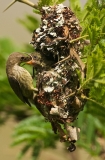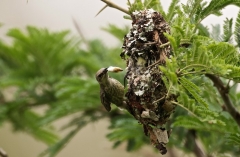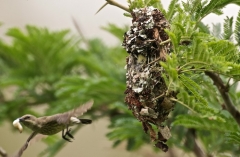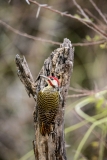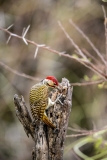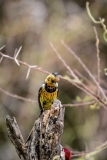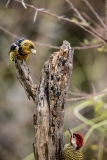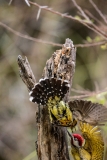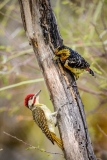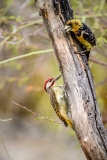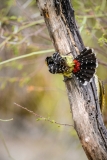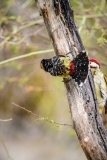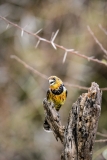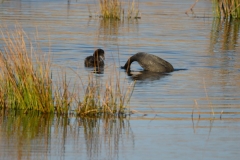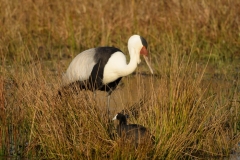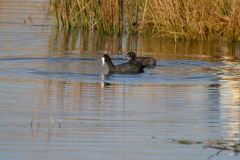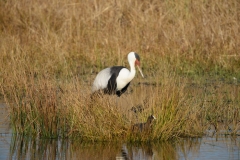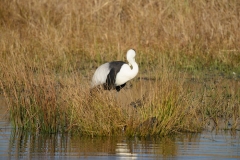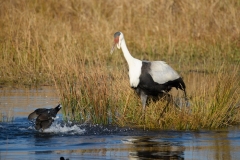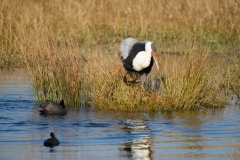Saddle-billed Stork: Brood Patch:
This is a patch bare of skin that some birds develop during the breeding season in order to ensure direct contact between the eggs and the parent for transfer of heat during incubation.
Either one or both parents develop brood patches, depending on who is responsible for the incubation.
At the beginning of the breeding season hormones cause the skin on the belly to become thickened, causing the feathers to fall out.
The brood patch is richly supplied with blood in a network of capillaries close to the skin. The feathers re-grow towards the end of the incubation period.
Look out for a brood patch in the Saddle-billed Stork, it almost resembles a heart in position and shape.
- Male has brown eyes and small yellow wattle
- Female has yellow eyes and lacks wattle


Observing the Purple-Banded Sunbirds at their nest!
These are a few of the photos of the purple-banded sunbirds that I took in Hluhluwe/Umfolozi in October 2011. I spent over four hours at this nest observing the feeding of the two chicks by both the male and female!
But what was really interesting was that in that time period I observed twice the removal of the faecal sac by the female. The male did not assist with this task!
The first photos are of the male and female feeding the chicks and then the subsequence of the female feeding and removal of faecal sac follow.
After photographing the sunbirds I went back upstairs to the deck to have lunch. While we were having our lunch some monkeys appeared. Within two minutes the monkeys were in the acacia tree and destroyed the nest of the sunbirds!
The young chicks were also removed by the monkeys!
The sad part for me was that the chicks were within a day or two of leaving their nest for the first time!
I did not observe the male and female sunbirds that afternoon and had to leave early the next day. Friends of ours stayed on and they observed the next day that the male and female were hard at work again rebuilding a new nest in the same acacia tree!!
All in all an interesting observation.
Crested Barbet fights off a male Bennett’s Woodpecker
I was watching the woodpecker tapping away at an old tree stump and suddenly drama! The Barbet flies in and immediately takes on the woodpecker! Chasing it around the stump and then eventually “coming out on top”!!
Coots
I spent a few weeks at a small dam in the Karkloof observing a pair of Wattled Crane on the nest. It was quite interesting to see the interaction between the Wattled Cranes and the other species of birds. I found some interesting information in the book “Waterbirds” by Nigel Dennis and Warwick Tarboton. The Redknobbed Coot was a most interesting bird to observe! They just kept dipping there heads into the water! Why?
Warwick Tarboton explains that “Coots are vegetarians and they eat submerged aquatic plants such as Potamogeton pectinatus by simply dipping their heads into the water and pulling out their food. Coot numbers on dams correlate well with the size of the submerged plant crop, and the plant crop, in turn, is dependent on the nutrient level of the water. A great many dams (and other waterbodies) have been enriched to varying degrees by agricultural fertilizers and other nutrients draining into them, a process called eutrophication, and many of these are rapidly colonized by Potamogeton to the fisherman’s disgust but coot’s delight. Although coots look barely capable of sustained flight, they are inveterate travellers across the night skies and they find newly filled dams with unerring predictability. Ringing has shown that they commute up and down the subcontinent; one was even sighted in the open sea 15 kilometres offshore of Durban, reaffirming the adage ‘as crazy as a coot’ “.
extract from the book “Waterbirds- Birds of Southern Africa’s Wetlands” by Nigel Dennis and Warwick Tarboton. (with kind permission from the author)
To continue with my observation: The Coot was now irritating the Wattled Crane and eventually the crane retaliated!
Plovers were also an irritation to the Wattled Cranes!

